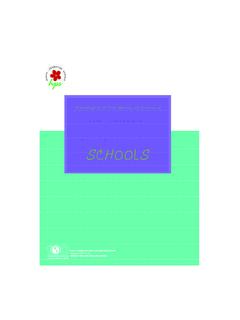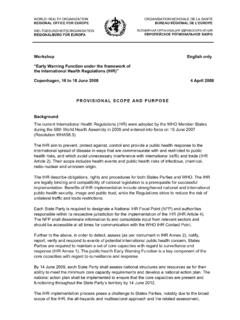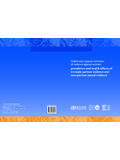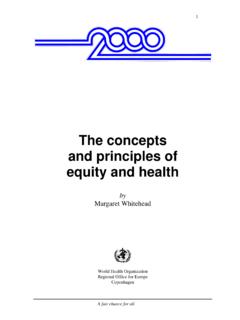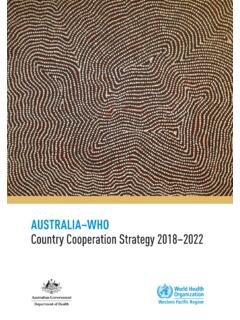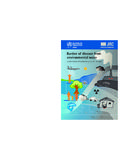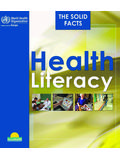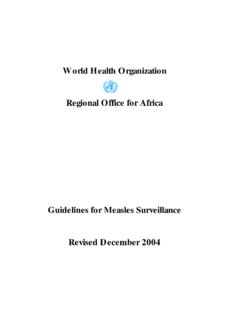Transcription of NIGHT NOISE GUIDELINES (NNGL) FOR EUROPE
1 world health organization regional OFFICE FOR EUROPE WELTGESUNDHEITSORGANISATION REGIONALB RO F R EUROPA ORGANISATION MONDIALE DE LA SANT BUREAU R GIONAL DE L'EUROPEВСЕМИРНАЯ ОРГАНИЗАЦИЯ ЗДРАВООХРАНЕНИЯЕВРОПЕЙСКОЕ РЕГИОНАЛЬНОЕ БЮРОEUROPEAN CENTRE FOR ENVIRONMENT AND health BONN OFFICE NIGHT NOISE GUIDELINES ( nngl ) FOR EUROPE Grant Agreement 2003309 Between the European Commission, DG Sanco and the world health organization , regional Office for EUROPE Final implementation report world health organization 2007 This project was co-sponsored by the European Commission. The views expressed in this report can in no way be taken to reflect the official opinion of the European Commission or the world health organization . The designations employed and the presentation of the material in this report do not imply the expression of any opinion whatsoever concerning the legal status of any country, territory, city or area or of its authorities, or concerning the delimitation of its frontiers or boundaries.
2 The world health organization does not warrant that the information contained in this publication is complete and correct and shall not be liable for any damages incurred as a result of its use. 2 3 Table of contents Introduction ..5 Project activities Manpower for the execution of the Partners Countries involved ..10 Achievement of the objectives ..13 Project result 1: Summary of NIGHT NOISE GUIDELINES for 1 Introduction ..16 2 Process of developing GUIDELINES ..17 3 NOISE 4 Sleep time ..17 5 NOISE , sleep and 6 Vulnerable groups ..19 7 Thresholds for observed effects ..19 8 Relations with Lnight, 9 Recommendations for health protection ..23 10 Relation to the 2000 WHO GUIDELINES for Community Project result 2: Unedited final document of NIGHT NOISE GUIDELINES for EUROPE .
3 26 Project result 3: Technical report on the NIGHT -weighting factor in Annex 1: List of partners of nngl project ..201 Annex 2: List of contributors ..202 Annex 3: Report on the first planning meeting on NIGHT NOISE GUIDELINES ..205 Annex 4: Report on the second meeting on NIGHT NOISE GUIDELINES ..233 Annex 5: Report on the third meeting on NIGHT NOISE Annex 6: Meeting report on the fourth meeting on NIGHT NOISE Annex 7: Report on the final meeting for consensus building on NIGHT NOISE 4 5 Introduction Policies and legislations aiming at NIGHT NOISE control are often based on sleep disturbance in European countries. However, the impacts of NOISE -induced sleep disturbance on health , either short-term or long-term, have not been investigated comprehensively to support policy-makers.
4 From June 2003 until December 2006, WHO regional Office for EUROPE European Centre for Environment and health (Bonn office) implemented the NIGHT NOISE Guideline ( nngl ) project co-sponsored by the European Commission. The goal of the nngl project was to provide expertise and scientific advice to the European Commission and its Member States in developing future legislations in the area of NIGHT NOISE exposure control and surveillance. The key objectives of the project was to reach a consensus of experts and stakeholders on the following subjects: (a) guideline values for NIGHT NOISE to protect the public from adverse health effects, (b) an agreement on the NIGHT penalty factor to be allocated to NIGHT time NOISE in the calculation of Lden.
5 The methodology of developing NIGHT NOISE GUIDELINES was based on the WHO publication EUR/00/5020369 Evaluation and use of epidemiological evidence for environmental risk assessment that can be accessible at Project activities conducted The work was performed according to the following process. WHO coordinated overall project activities, providing terms of reference, organising meetings, ensuring timely production of working documents. The partner institutions agreed to participate in one or more working groups and devote a minimum of 6 working days per year for reviewing documents and attending meetings. Experts were contracted with WHO for making scientific reviews of existing literature and for contributing to the contents of the project products.
6 The project activities were performed according to the following sequence. Planning MeetingWorking group 1 Working group 2 Working group 3- Terms of reference- Consultants -Invited / contracted expertsExternal peer reviewFinal consensus me e ting o n: - nngl -National agreementMeeting 2 Meeting 1 Meeting 3 PublishingEditingPlanning MeetingPlanning MeetingWorking group 1 Working group 2 Working group 3- Terms of reference- Consultants -Invited / contracted expertsExternal peer reviewFinal consensus me e ting o n: - nngl -National agreementFinal consensus me e ting o n: - nngl -National agreementMeeting 2 Meeting 1 Meeting 3 Meeting 2 Meeting 2 Meeting 1 Meeting 1 Meeting 3 Meeting 3 PublishingEditing 61. Identification of the major health end points relevant to sleep disturbance caused by environmental NOISE (June 2004 May 2005) 2.
7 Comprehensive identification and systematic review of the existing body of evidence, and expert consensus on guideline values (December 2004 August 2006) 3. Final consultation for harmonizing the proposed guideline values (October 2005 - December 2006) 4. A final meeting gathering the best available experts and adopting the final guideline values for NIGHT NOISE exposure (December 2006) 5. Reporting and dissemination (December 2006 - March 2007) The key milestones of project activities were technical meetings of topic-specific experts in the field of acoustics, exposure assessment, sleep pathology, accident epidemiology, immunology, mental health , and health impact assessment. The experts produced the background papers based on their review of scientific evidence on the impacts of NOISE on sleep and health .
8 These background documents were synthesized into one document proposing health -based GUIDELINES . This document was then distributed among the experts and stakeholders for final peer-review. The final products of the project were discussed at the final meeting of experts and stakeholders where the consensus on the guideline values was reached. Although some administrative problems arose due to the replacement of two partners at the beginning of the project in 2003, the project was implemented according to the plan outlined in the project proposal. All meeting reports are attached to this final report as Annexes. These meeting reports describe all the activities conducted to achieve the objectives of the project. The first technical meeting was held in Bonn, at the premises of the WHO/EURO - European Centre for Environment and health , June 2004.
9 It gathered the project partners, experts and national government officers to define the work plan and discuss organizational issues. This meeting was crucial to define the timetable, allocate responsibilities, organise team coordination, the logistics and finance. A first draft of the table of contents of the GUIDELINES document was discussed. The WHO prepared the background material of the meeting and each partner presented his/her field of knowledge and future role on the project. WHO suggested the partners to cover specialized topics, but they also could decide themselves which issue to contribute to. The second technical meeting took place in Geneva at the WHO/HQ premises, December 2004.
10 It concentrated on the methodological issues of exposure assessment, metrics, health effects, and formulation of GUIDELINES . The partners presented the first draft papers for the different identified topics and detailed discussion took place for each one of them. The discussions concentrated mainly on central issues like exposure assessment and guideline derivation. The WHO organized and prepared the background material and some partners prepared papers. The discussion was around the papers and on the way forward, especially to address lacks on evidence and what (and how) to consider as health outcome. The third technical meeting in Lisbon at the premises of the DGS (Direc o Geral da Sa de Portuguese Directorate General for health ), April 2005, reviewed the final version of the background papers and discussed how to finalize and build consensus until the end of the project.










